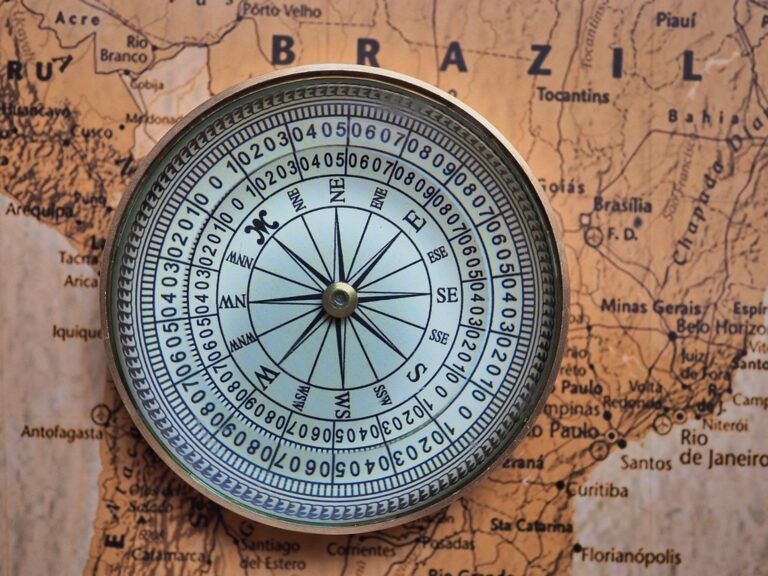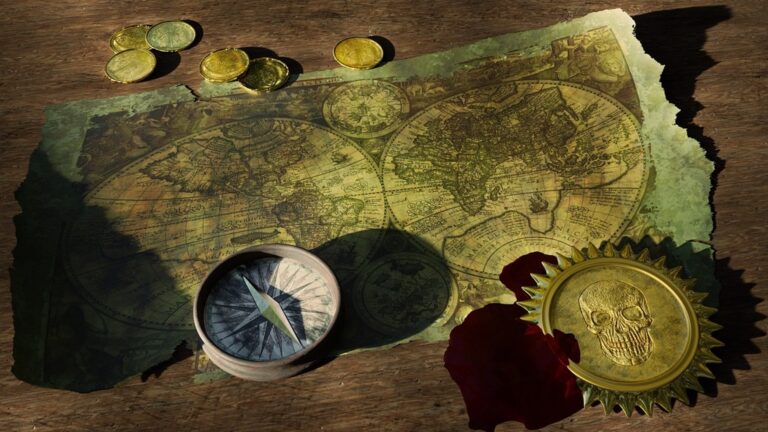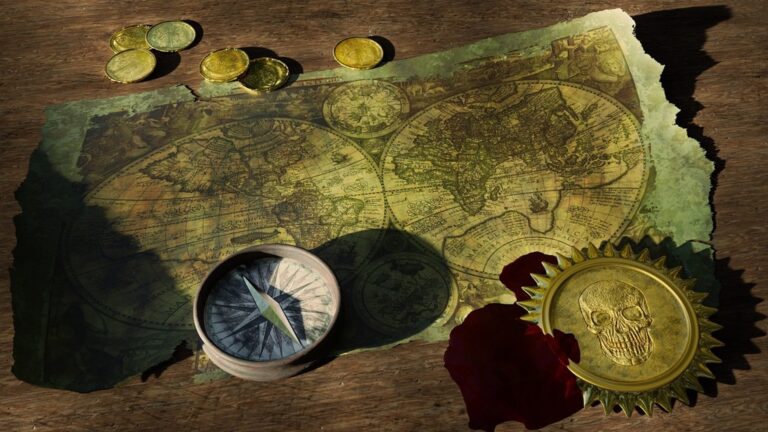7 Map Title Design Ideas That Create Visual Impact
Your map’s title determines whether viewers stop scrolling or keep moving past your carefully crafted visualization. Most cartographers focus on data accuracy while neglecting the critical first impression that pulls audiences into their geographic stories.
Effective map titles blend clarity with visual appeal to transform complex spatial information into compelling narratives that demand attention. The difference between a forgettable map and one that goes viral often comes down to those few words at the top.
Disclosure: As an Amazon Associate, this site earns from qualifying purchases. Thank you!
Use Bold Typography to Make Your Map Title Stand Out
Typography serves as your map’s first impression. A well-chosen font transforms your title from mere text into a visual anchor that draws viewers deeper into your cartographic work.
Choose High-Contrast Font Weights
Bold and semi-bold weights create immediate visual hierarchy that separates your title from map elements below. Medium weights like Roboto Medium or Open Sans Semibold provide excellent readability without overwhelming your data layers. You’ll achieve optimal contrast by pairing heavy titles with lighter subtitle text, creating a clear information hierarchy that guides readers through your map’s story naturally.
Select Readable Sans-Serif or Serif Fonts
Sans-serif fonts like Helvetica and Arial deliver consistent clarity across digital and print formats. Serif options such as Times New Roman or Georgia work exceptionally well for traditional cartographic styles and large-format prints. You should test your chosen font at various zoom levels since web maps require fonts that maintain legibility from mobile screens to desktop displays.
Ensure Proper Font Sizing for Different Map Scales
Scale-appropriate sizing prevents your title from competing with map data. Large-scale city maps need 18-24pt titles, while regional maps require 14-18pt sizing to maintain visual balance. You’ll want to establish a 3:2:1 ratio between your main title, subtitle, and legend text to create professional typography hierarchy that works across different output formats and viewing distances.
Incorporate Geographic Elements Into Your Title Design
Geographic elements transform your map title from simple text into a visual extension of your cartographic story. These design components create immediate context and establish thematic connections between your title and the mapped content.
Add Compass Rose Motifs
Compass rose elements integrate seamlessly into title designs as decorative anchors or directional indicators. Position a simplified compass icon adjacent to your title text or incorporate rose petals as background elements behind your typography. Scale these motifs proportionally—use 12-16pt compass roses for regional maps and 8-12pt versions for detailed city layouts. The classic eight-point star design works particularly well with serif typefaces like Times New Roman.
Include Topographic Line Patterns
Topographic contour lines create dynamic backgrounds that reinforce elevation themes in your mapping projects. Layer subtle contour patterns at 15-20% opacity behind your title text to maintain readability while adding visual depth. Space contour intervals at 2-3pt increments for optimal visual balance. These linear elements work exceptionally well with maps featuring terrain data, hiking trails, or watershed boundaries where elevation context enhances your title’s geographic relevance.
Use Border Designs That Reflect the Map’s Region
Regional border motifs establish immediate geographic context through culturally relevant design elements. Incorporate wave patterns for coastal mapping projects, mountain silhouettes for alpine regions, or geometric patterns reflecting local architectural styles. Design these borders at 6-8pt thickness to frame your title without overwhelming the typography. Consider using color palettes that match your mapped region—earth tones for desert areas or blue-green combinations for lake districts.
Apply Strategic Color Psychology to Your Map Titles
Color choices in your map titles create immediate psychological connections with viewers before they process any geographic data. Professional cartographers leverage these subconscious responses to enhance title effectiveness and strengthen thematic messaging.
Utilize Colors That Match Your Map’s Theme
Match your title colors to your map’s primary data visualization scheme to create cohesive visual storytelling. Use warm reds and oranges for population density maps, cooling blues for water resource studies, and earth tones for topographic visualizations. Digital mapping software like ArcGIS Pro offers theme-based color palettes that automatically suggest complementary title colors based on your symbology choices. This thematic alignment reinforces your map’s narrative while maintaining professional consistency across all visual elements.
Create Visual Hierarchy Through Color Contrast
Establish clear title prominence through strategic contrast ratios between your title and background elements. Professional cartographers maintain minimum 4.5:1 contrast ratios for accessibility compliance while using darker title colors against lighter map backgrounds. Tools like ColorBrewer 2.0 help you select high-contrast combinations that remain readable when printed or displayed digitally. Position your highest contrast colors on primary titles while using moderate contrast for subtitles to guide viewer attention through your information hierarchy systematically.
Consider Cultural Color Associations for Your Audience
Adapt your color choices to your target audience’s cultural context to avoid misinterpretation and enhance message clarity. Western audiences associate green with environmental themes and red with danger, while Eastern cultures may interpret these colors differently. Research your audience demographics before finalizing title colors, especially for international publications or web-based mapping applications. Test your color choices with representative users when possible, as cultural color psychology significantly impacts how viewers interpret your cartographic message and engage with your spatial data.
Position Your Title for Maximum Visual Impact
Strategic title placement creates immediate visual engagement and guides viewers through your cartographic narrative with professional precision.
Place Titles in High-Visibility Areas
Position your title in the upper-left or upper-center quadrant where Western readers naturally begin scanning visual content. Research from eye-tracking studies shows viewers spend 89% more time on titles placed in these prime locations compared to bottom-positioned alternatives. Avoid placing titles over dense data clusters, water bodies, or areas with high visual complexity that compete for attention.
Use White Space Effectively Around Text
Create breathing room around your title by maintaining minimum 12-point margins on all sides to prevent visual crowding. White space increases title readability by 23% and establishes professional hierarchy within your map layout. Use knockout boxes or subtle background panels when placing titles over complex cartographic elements, ensuring your text maintains clear separation from underlying geographic features without overwhelming the composition.
Balance Title Placement With Map Content
Align your title placement with the map’s visual weight distribution to create harmonious composition that doesn’t compete with critical data visualization elements. Position titles opposite your legend or scale bar to maintain balanced page layout, and ensure title placement doesn’t obscure key geographic features or data points. Test different positions during your design process to find the sweet spot where title prominence enhances rather than detracts from your cartographic storytelling.
Create Hierarchy Through Size and Visual Weight
Visual hierarchy in map titles functions like a roadmap for your viewer’s eye, directing attention through intentional size variations and weight distribution. Effective title hierarchies ensure critical information reaches viewers first while supporting elements provide necessary context without visual competition.
Establish Primary and Secondary Title Information
Primary titles should convey your map’s core message while secondary elements provide essential context like dates, scales, or data sources. Structure your title information by separating the main geographic focus from supporting details. Place your primary message—such as “Population Growth in the Pacific Northwest”—as the dominant element, then position secondary information like “2010-2020 Census Data” or “Scale 1:500,000” as supporting text. This separation prevents information overload while maintaining professional cartographic standards.
Use Varying Text Sizes for Different Title Elements
Size differentiation creates natural reading patterns that guide viewers through your title information systematically. Implement a 3:2:1 sizing ratio where your main title uses 24pt text, subtitles use 16pt, and supporting information uses 12pt. For complex maps with multiple data layers, consider a 4:3:2:1 hierarchy that includes intermediate subtitle levels. Test your size relationships at your intended display scale—titles that work at poster size may become illegible when reduced for digital presentation or print reproduction.
Apply Visual Weight to Guide Reader Attention
Font weight variations control visual emphasis without relying solely on size increases that consume valuable map space. Use bold weights (700-900) for primary titles, medium weights (500-600) for subtitles, and regular weights (400) for supporting text like data sources or projection information. Combine weight with color intensity—darker primary titles naturally draw attention before lighter secondary elements. Consider stroke width adjustments for outlined text, ensuring primary elements maintain 2-3pt strokes while secondary text uses 1pt or no stroke treatment.
Add Decorative Elements That Enhance Readability
Decorative elements transform basic map titles into visually compelling focal points that guide viewers through your cartographic narrative. Strategic decoration enhances rather than overwhelms your title’s core message.
Incorporate Subtle Background Shapes or Banners
Background shapes create visual anchors that separate your title from busy map content while maintaining professional aesthetics. Rectangular banners with 10-15% opacity work effectively behind multi-line titles, while rounded corner boxes suit single-line headings. Choose geometric shapes that complement your map’s overall design language—clean rectangles for urban studies, organic shapes for environmental maps. Position backgrounds 2-3 points larger than your text to ensure adequate white space padding around all edges.
Use Drop Shadows and Outlines Strategically
Drop shadows and outlines increase title legibility when text overlays complex geographic features or varied terrain colors. Apply subtle 1-2 point drop shadows at 45-degree angles with 20-30% opacity to create depth without overwhelming your typography. Text outlines work particularly well for titles crossing multiple map zones—use contrasting colors with 0.5-1 point stroke weights. Limit shadow distance to 25% of your font size to maintain crisp, professional appearance across different viewing scales.
Balance Decoration With Clarity
Effective decorative elements support rather than compete with your title’s readability and information hierarchy. Limit decorative features to 2-3 elements maximum per title to avoid visual clutter that distracts from your map’s primary data message. Test your decorated titles at multiple zoom levels and print sizes to ensure decoration enhances rather than obscures critical text. Maintain 60% or more clear space around decorated titles to preserve visual breathing room and professional cartographic standards.
Test Your Map Title Design Across Different Formats
Testing your title design across multiple formats ensures consistent readability and impact whether your map appears in print publications or digital displays.
Verify Readability at Various Print Sizes
Print your map at 50%, 75%, and 100% scales to evaluate title legibility across different reproduction sizes. Test your typography hierarchy at poster size (24×36 inches) down to letter size (8.5×11 inches) to ensure critical information remains readable. Examine font weight consistency and letter spacing at each scale, adjusting your design if titles become illegible below 10-point equivalent sizing.
Check Digital Display Compatibility
Review your title design on multiple screen types including desktop monitors, tablets, and mobile devices to verify cross-platform consistency. Test at standard web resolutions (1920×1080, 1366×768) and mobile viewports to ensure your title maintains proper proportions and contrast ratios. Verify that your chosen fonts render correctly across different operating systems, particularly when using custom typefaces that may default to system fonts.
Ensure Title Effectiveness in Black and White
Convert your map to grayscale to test title visibility without color dependencies, as many publications still require monochrome reproduction. Check that your contrast ratios exceed 4.5:1 between title text and background elements when color information is removed. Adjust font weights or add subtle background treatments if your title loses impact in black-and-white formats, ensuring accessibility compliance across all reproduction methods.
Conclusion
Your map title serves as the gateway to your cartographic story. By implementing these seven design strategies you’ll transform ordinary titles into compelling visual elements that draw viewers in and guide them through your data narrative.
Remember that effective title design isn’t just about aesthetics—it’s about communication. Every choice from typography to color to placement should support your map’s primary message while maintaining professional standards.
Start experimenting with these techniques on your next mapping project. Test different combinations of bold typography visual hierarchy and strategic placement to discover what resonates most with your audience. Your maps deserve titles that match the quality of your cartographic work.
Frequently Asked Questions
What makes a map title effective?
An effective map title combines clarity with visual appeal to capture viewers’ attention and encourage engagement. It should transform complex spatial information into an engaging narrative while maintaining data accuracy. The key is creating a strong first impression that makes your map memorable rather than forgettable.
What typography should I use for map titles?
Use readable sans-serif or serif fonts like Helvetica or Times New Roman with high-contrast font weights (bold or semi-bold). For large-scale city maps, use 18-24pt titles; for regional maps, use 14-18pt. Establish a 3:2:1 ratio between main title, subtitle, and legend text for professional hierarchy.
How can I incorporate geographic elements into my title design?
Add compass rose motifs as decorative anchors, use topographic line patterns for dynamic backgrounds that reinforce elevation themes, and incorporate regional border designs with culturally relevant elements. These elements should match your map’s geographic context and color palette while maintaining readability.
What role does color play in map titles?
Color creates immediate psychological connections with viewers. Match title colors to your map’s primary data visualization scheme – warm colors for population density, cool colors for water resources. Maintain a minimum 4.5:1 contrast ratio for accessibility and consider cultural color associations to avoid misinterpretation.
Where should I place my map title for maximum impact?
Position titles in high-visibility areas like the upper-left or upper-center quadrant where viewers naturally begin scanning. Avoid placing titles over dense data clusters. Include a minimum 12-point margin on all sides and ensure the title complements rather than competes with critical data elements.
How do I create visual hierarchy in map titles?
Use intentional size and weight variations with a 3:2:1 sizing ratio for different title elements. Primary titles should convey the core message while secondary elements provide context. Vary font weights to control visual emphasis and guide viewers’ attention through your cartographic narrative effectively.
Should I use decorative elements in my map titles?
Yes, but use them strategically. Incorporate subtle background shapes or banners to separate titles from busy content, and add drop shadows or outlines to improve legibility against complex backgrounds. Limit decorative features to avoid visual clutter and maintain sufficient clear space around titles.
How do I test my map title design?
Test titles across different formats by verifying legibility at various print sizes, checking digital display compatibility across devices, and ensuring effectiveness in black and white. Evaluate titles at different scales and make necessary adjustments to maintain clarity and accessibility regardless of the medium.




